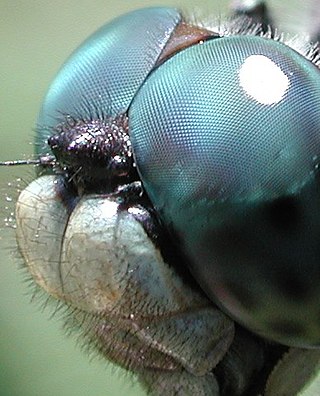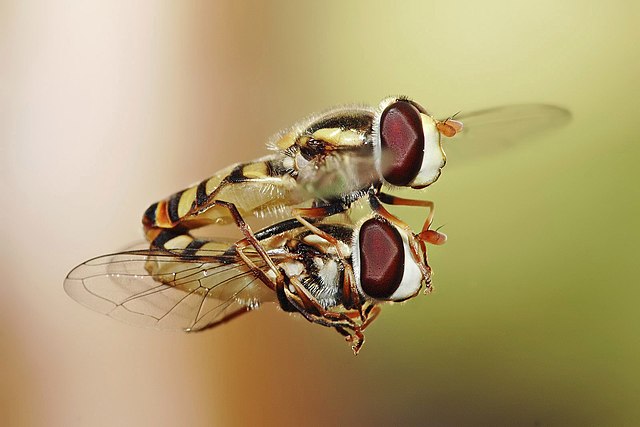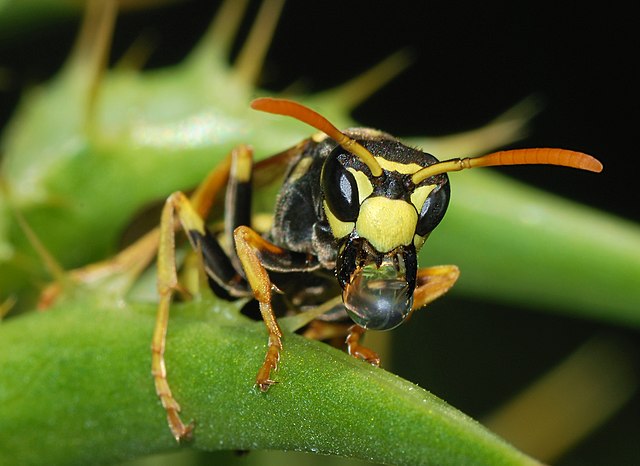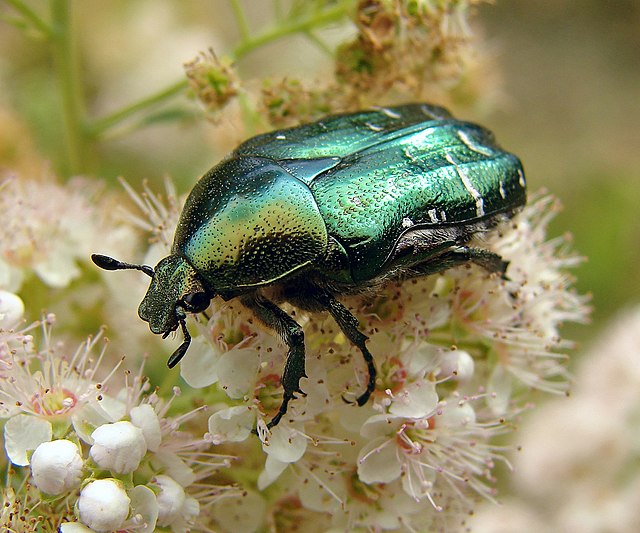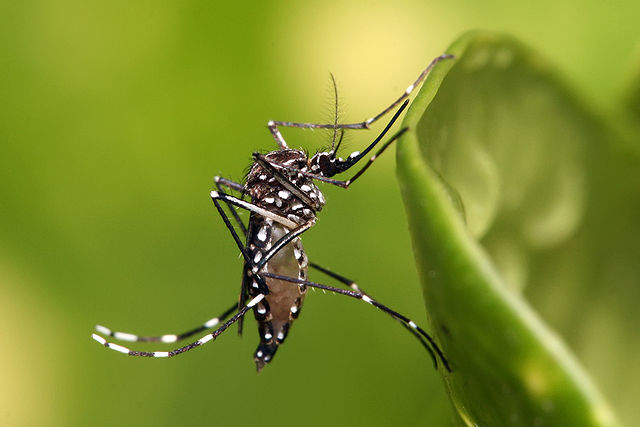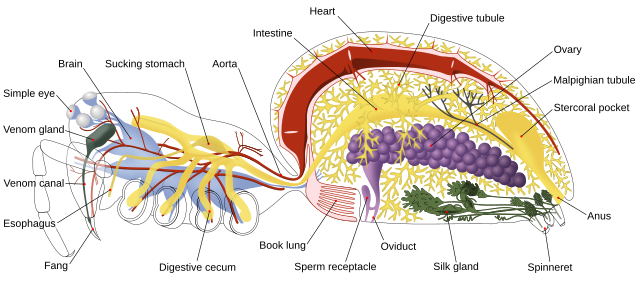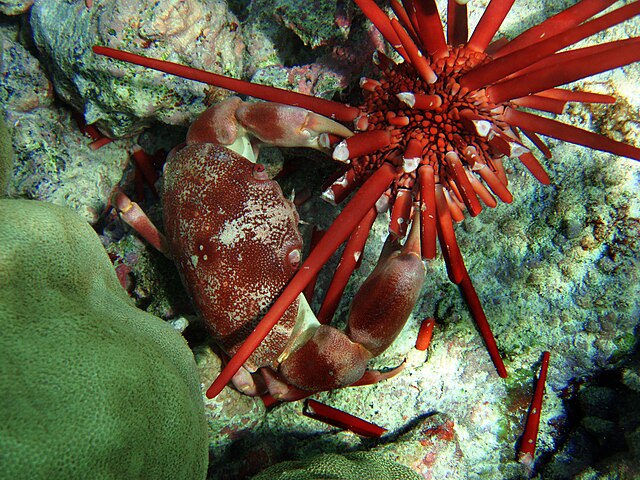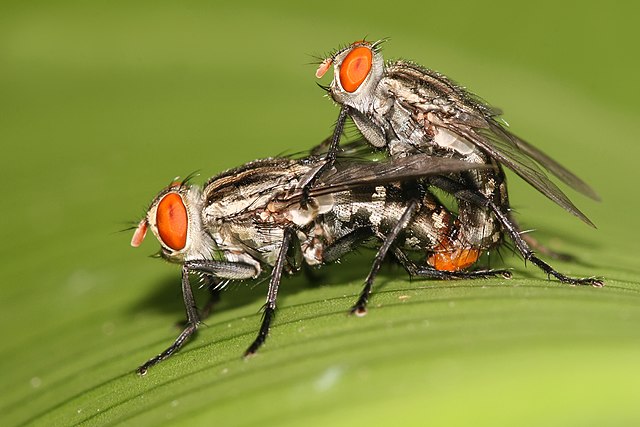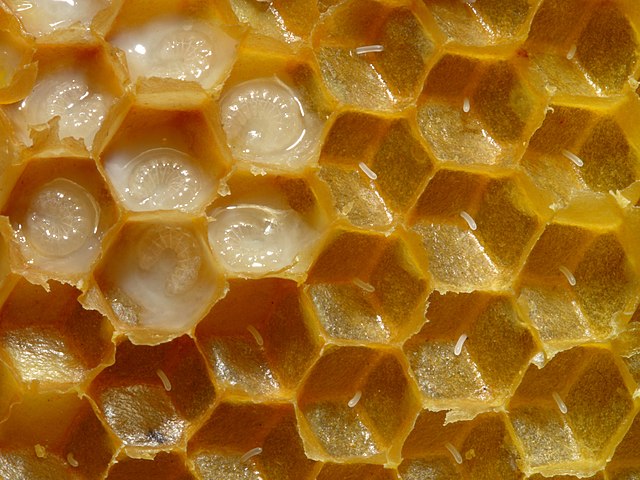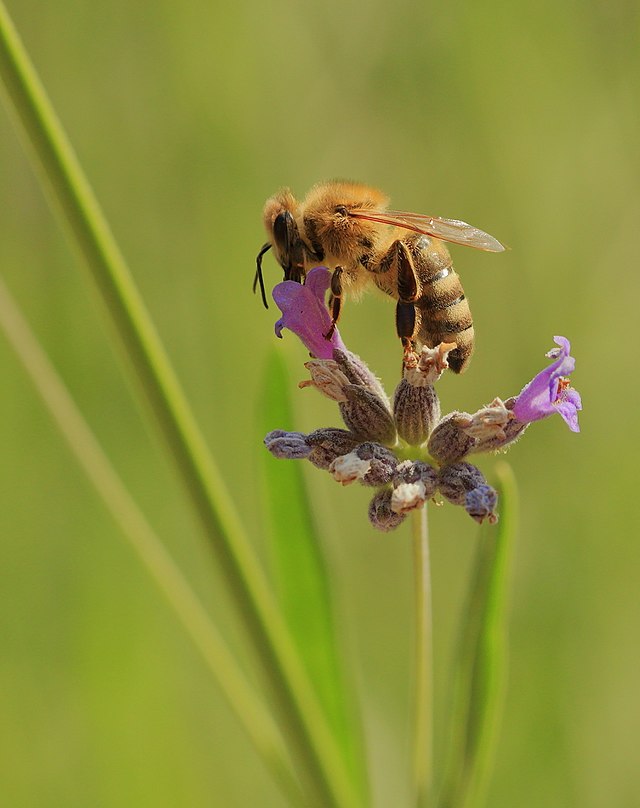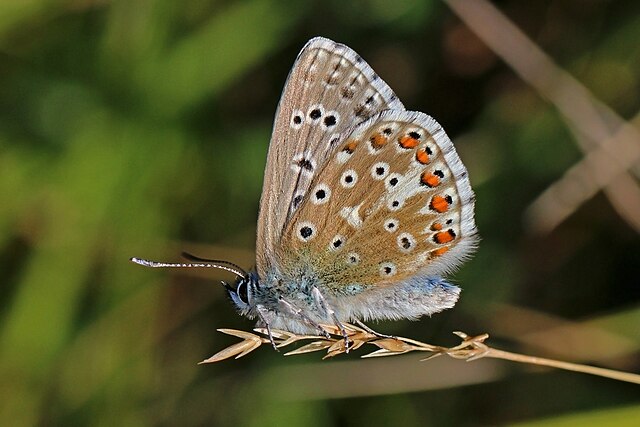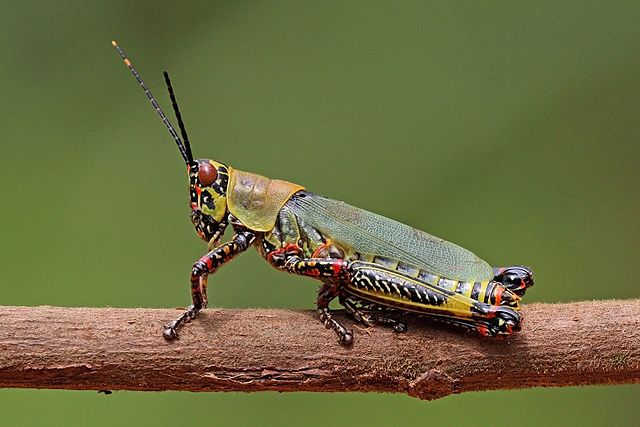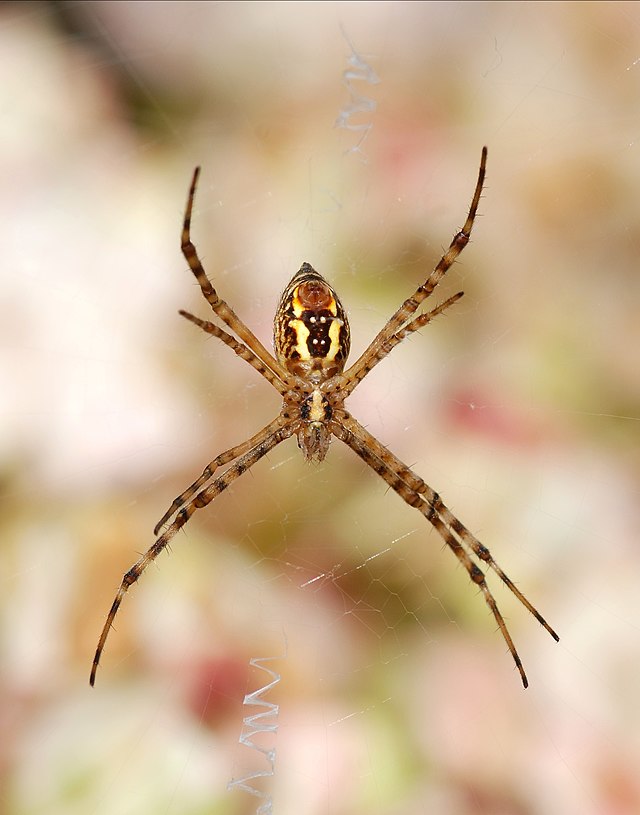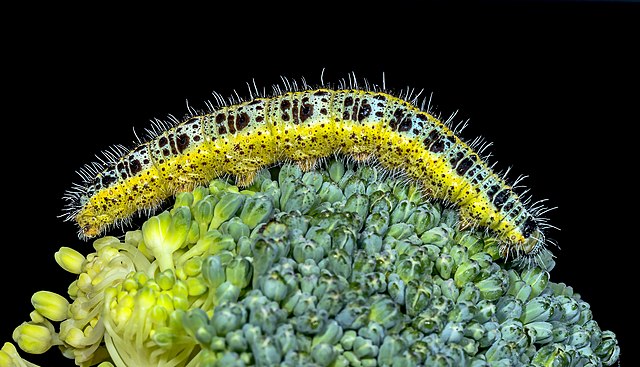Top Qs
Timeline
Chat
Perspective
Portal:Arthropods/Selected picture
From Wikipedia, the free encyclopedia
Remove ads
The Selected picture box on the portal chooses one of the following at random when displaying the page. Follow the instructions below for adding or nominating a new picture to the list.
Picture candidates
Feel free to add related featured pictures to the list. Nominate other pictures on the portal talk page.
- Pictures must be
- Free to use and hosted on Commons
- Of good quality (not blurred, grainy or discoloured)
- Interesting
- Relevant to an article or topic
To find appropriate pictures, use search box below:
Instructions
- For pictures, which appeared as picture of the day on the Main Page, just add the date in
YYYY-MM-DDformat to the list (please keep the list sorted). - For other pictures, use following parameters:
|iN= |titleN= |creditN= |captionN=
where N is the next unused number.
Remove ads
Selected pictures list
Photo credit: David L. Green
A compound eye is a visual organ found in certain arthropods. The compound eye consists of between 12 and 1,000 ommatidia, little dark/bright sensors. The image perceived by the arthropod is "recalculated" from the numerous ommatidia which point in slightly different directions. In contrast to other eye types, there is no central lens or retina. Though the resulting image is poor in resolution, it can detect quick movements and, in some cases, the polarization of light.
Dragonflies have about 30,000 facets to their compound eyes, giving them nearly a 360° field of vision.
Photo credit: Fir0002
The Polyphemus Moth (Anthera polyphemus) is one the biggest moths, having a wingspan of up to 15 cm. Usually found in forests, moths are notable for apparently being attracted to light, the reason for this behaviour is not known.
Photo credit: Jon Sullivan
A honey bee extracts nectar from a flower using its proboscis. Tiny hairs covering the bee's body maintain a slight electrostatic charge, causing pollen from the flower's anthers to stick to the bee's hairs, allowing for pollination when the bee moves on to another flower.
A macro shot of the head of a dragonfly, focusing on its compound eyes. Dragonfly eyes have up to 30,000 facets; each one is a separate light-sensing organ or ommatidium, arranged to give nearly a 360° field of vision.
Photo credit: Keith Weller, Agricultural Research Service
The citrus root weevil (Diaprepes abbreviatus) is a major agricultural pest weevil in several Caribbean countries and the U.S. state of Florida. The larvae feed on the roots of the host plant for several months. They often eat the taproot of the plant, which can kill it by depriving it of water and nutrients or by making it vulnerable to infection by fungi, or water moulds.
Hoverflies mating
Photo credit: Fir0002Two Melangyna viridiceps (called Common Hoverflies in Australia) mating in mid-air. The male, which can be identified by the eyes meeting at the top of its head, is on top. The term "hoverfly" refers to about 6,000 species of flying insects in the family Syrphidae. They are often seen hovering at flowers and are important pollinators.
Photo credit: Fir0002
A mole cricket, an insect belonging to the Gryllotalpidae family. Mole crickets are common insects, found on every continent except Antarctica, but because they are nocturnal and spend nearly all their lives underground in extensive tunnel systems, they are rarely seen. This specimen is likely to be Gryllotalpa brachyptera and is about 3.5 cm (1.4 in.) in size.
Image credit: Erbe & Pooley, ARS
Varroa destructor, a species of mite, is seen parasitizing a honeybee host in this digitally colorized low-temperature scanning electron microscope image. Varroa mites threaten agricultural pollination directly by weakening and destroying bee colonies. They also mandate more regular management of hives that is both labor-intensive and expensive.
Photo credit: Richard Bartz
A male Roesel's bush-cricket (Metrioptera roeseli), a European bush-cricket named after August Johann Rösel von Rosenhof, a German entomologist. Its song is very similar to that of Savi's Warbler. Its body length as an adult insect is 15 to 18 mm. It is brown with a pale margin to the sides of the pronotum. Its forewings usually reach midway along its abdomen at rest. However there is a macropterous form of this insect (f. diluta), in which the wings reach beyond the tip of the abdomen. This form appears predominantly during hot summers and enables the species to extend its geographical range rapidly while conditions are suitable; such migrations may also be in response to local overpopulation.
A fishing spider with two of its legs missing. Most likely some predator (a bird, or given its habitat a large fish or frog) grasped the spider by the missing limbs which were jettisoned by the spider in response, a process known as autotomy.
Photo credit: Fir0002
The head and mandibles of an Australian bull ant. Insect mandibles grasp, crush, or cut the insect’s food, or defend against predators or rivals. These mandibles move in the horizontal plane unlike those of the vertebrates.
Photo credit: Derek Ramsey
The monarch butterfly (Danaus plexippus) is one of the best-known species of butterfly. Its wings feature an easily recognizable orange and black pattern, with a wingspan of 8.9–10.2 centimetres (3½–4 in).
Photo credit: Joaquim Alves Gaspar
A European paper wasp (Polistes dominula) heating a bubble of regurgitated fluid in the sunlight. This is a common practice among many winged insects, and it is believed to be a way to facilitate digestion or to cool themselves off.
Photo credit: Kevin Cole
The face of a Dungeness crab (Cancer magister), a common crab found from the Aleutian Islands in Alaska to Santa Cruz, California. The two eyes sit on eyestalks, with two antennules on either side of the rostrum (center, above the mouth).
Photo credit: Chrumps
The rose chafer (Cetonia aurata) is a reasonably large beetle (20 mm/¾ in long) that has metallic green coloration with a distinct V shaped scutellum, the small triangular area between the wing cases just below the thorax. Rose chafers are found over southern and central Europe and the southern part of the UK.
Photo credit: Richard Bartz
A female subimago of a March Brown mayfly (Rhithrogena germanica). Mayflies belong to the order Ephemeroptera, and the only insects that have a subimago phase. This stage is a favourite food of many fish, and many fishing flies are modeled to resemble them. They are aquatic insects whose nymph stage usually lasts one year in freshwater. The adults are short-lived, from as little as thirty minutes to a few days depending on the species.
Photo credit: Tom Friedel
Two Eastern Lubber grasshoppers (Romalea guttata) mating. Native to the southeastern and south central portion of the United States, it is well known both for its size and its unique coloration. During reproduction, the male grasshopper introduces sperm into the ovipositor through its aedeagus (reproductive organ), and inserts its spermatophore, a package containing the sperm, into the female's ovipositor.
Photo credit: Fir0002
An assassin bug belonging to the Reduviidae family of insects. A predatory insect so named because of its tendency to wait in ambush for its prey, the assassin bug uses its long rostrum to inject a lethal saliva that liquefies the internal structures of the prey, which are then sucked out.
Photo credit: Joaquim Alves Gaspar
The Painted Lady (Vanessa cardui) is a well-known colourful butterfly, found on every continent except Antarctica. It occurs in any temperate zone, including mountains in the tropics. The species is resident only in warmer areas, but migrates in spring, and sometimes again in autumn.
Photo credit: Noodle snacks
The Forest scorpion (Cercophonius squama) is a scorpion native to southeastern Australia and Tasmania. The body is 25 to 40 millimetres (0.98 to 1.57 in) long, and coloured creamy yellow to orange brown with dark brown variegations. The legs are yellow with some dark brown pigment.
Photo credit: Muhammad Mahdi Karim
The yellow fever mosquito (Aedes aegypti) is a species of mosquito known for its ability to spread yellow fever and dengue fever. The mosquito can be recognized by the white markings on its legs and a marking in the form of a lyre on its thorax. Though originally from Africa, the yellow fever mosquito can now be found in tropical regions around the world.
Photo: Richard Bartz
A macro shot of the chelicerae of an engorged Ixodes ricinus species of tick, which is a vector for Lyme disease and tick-borne encephalitis in humans and louping ill in sheep.
Photo: Kaldari
A female Thiodina puerpera jumping spider. This species is commonly found in the Eastern United States, its range stretching along the Gulf Coast from Florida to Texas, and north to Kansas, Illinois, and Pennsylvania. Adult females are between 7 and 11 mm (0.28 and 0.43 in) in length and males are smaller.
Photo: Luc Viatour
The cryptic mantis (Sibylla pretiosa) is a mantid native to southern Africa. Its common name comes from its ability to grow asymmetrically to match the vegetation of its environment. They have unusual leaf-like projections on the joint of their four walking legs and leaf-like wings, generally the only green portion of the insect's otherwise brown and mottled exoskeleton. Adult females grow to 5–6 cm (2.0–2.4 in) in length while the males are generally about 1 cm smaller.
Photo: Noodle snacks
A Eusthenia species of stonefly. The order contains almost 3,500 known species, including the only known insects that are exclusively aquatic from birth to death. Stoneflies are believed to be one of the most primitive groups of Neoptera and are found worldwide, with the exception of Antarctica.
A macro view of a Gonia capitata fly feeding on honey, showing its proboscis and pedipalps (the two appendages protruding from the proboscis), two types of insect mouthparts. The proboscis actually comprises the labium, a quadrupedal structure, and a sponge-like labellum at the end. Flies eat solid food by secreting saliva and dabbing it over the food item. As the saliva dissolves the food, the solution is then drawn up into the mouth as a liquid. The labellum's surface is covered by minute food channels which form a tube leading to the esophagus, and food is drawn up the channels by capillary action.
Image: Ryan Wilson, after John Henry Comstock
The internal anatomy of a typical female two-lunged spider. The yellow items signify portions of the digestive system, red indicates the circulatory system, blue is the nervous system, pink is the respiratory system, and purple is the reproductive system. Lastly, the spinnerets and poison glands are shown in green.
The Globe Skimmer (Pantala flavescens) is the most widespread dragonfly species on the planet, found between about the 40th parallels of latitude, or where the annual mean temperature is above 20 °C (68 °F), except in Europe where there are only occasional sightings.
The head of a female Clynotis severus species of jumping spider. The eyes of a spider are called simple eyes (as opposed to compound eyes) because in each eye, a single lens collects and focuses light onto the retina. In this spider, the two largest eyes in the middle are the most acute. The remainder on the sides and on the top of its head are "secondary eyes".
Photo: JJ Harrison
The Meadow Argus (Junonia villida) is a species of butterfly native to Australasia. Its brown wings are each covered with two distinctive black and blue eyespots as well as white and orange marks that appear on the edge of the wings. Males and females are similar in appearance and size, with females being slightly larger.
Photo: Mila Zinkova
A crab of the species Carpilius convexus (left) feeding on a slate pencil urchin. Crabs are omnivores, feeding primarily on algae, and taking any other food, including molluscs, worms, other crustaceans, fungi, bacteria and detritus, depending on their availability and the crab species. For many crabs, a mixed diet of plant and animal matter results in the fastest growth and greatest fitness.
Two flesh-flies (Sarcophaga ruficornis species pictured) mating. The life cycle of the saprophagic flesh-fly larvae has been well researched and is very predictable. Different species prefer bodies in different states of decomposition, which allows forensic entomologists to extrapolate the time of death.
Photo: Nick Hobgood
The Emperor shrimp (Periclimenes imperator) is a species of shrimp with a wide distribution across the Indo-Pacific. It lives commensally on a number of hosts, including sea cucumbers (Bohadschia argus shown here).
Squilla mantis, a species of mantis shrimp, for sale at the fish auction of l'Ametlla de Mar in Catalonia, Spain. It is native to the Mediterranean Sea and adjacent warm parts of the Atlantic Ocean, where it burrows into muddy and sandy seabeds. It is the only native stomatopod to be fished for on a commercial scale in the Mediterranean.
Poli's stellate barnacle (Chthamalus stellatus) is a species of acorn barnacle common on rocky shores in South West England, Ireland, and Southern Europe. It is named after Italian scientist Giuseppe Saverio Poli. Depending upon environmental conditions and the amount of food available, it can reach up to 14 mm (0.55 in) in diameter.
Photo: Lt. Elizabeth Crapo, NOAA Corps
The red rock crab (Grapsus grapsus) is one of the most common crabs along the western coast of the Americas. Adults are quite variable in color, including brownish-red, mottled or spotted brown, pink, yellow, bright orange and red. It feeds on algae primarily, sometimes sampling other plant matter and dead animals.
The longtail tadpole shrimp (Triops longicaudatus) is a freshwater crustacean resembling a miniature horseshoe crab. It is one of the oldest animal species still in existence. Like its relative Triops cancriformis, the longtail tadpole shrimp is considered a living fossil because its basic prehistoric morphology has changed little in the last 70 million years, exactly matching ancient fossils.
Photograph: Muhammad Mahdi Karim
A nest of the tropical Asian giant honey bee, which consists of a single exposed honeycomb, an array of densely packed hexagonal cells made of beeswax. Honeycombs store food (honey and pollen) and house the "brood" (eggs, larvae, and pupae).
Photograph: JJ Harrison
Compound eyes on a blue bottle fly. Unlike simple eyes, which have a single concave photoreceptive surface, compound eyes consist of a number of individual lenses (called ommatidia) laid out on a convex surface; this means that they point in slightly different directions. Compound eyes provide a wide field of view and can detect fast movement, but have low resolution.
Photograph: Spongepuppy
Photograph: Alvesgaspar
Anthidium florentinum, a species of bee in the family Megachilidae. Bees are flying insects closely related to wasps and ants that are involved in pollination. There are nearly 20,000 known species of bees in seven recognized biological families. Bees are found on every continent except Antarctica, in every habitat on the planet that contains insect-pollinated flowering plants. Bees range in size from tiny stingless bee species whose workers are less than 2 millimetres (0.08 in) long, to Megachile pluto, whose females can attain a length of 39 millimetres (1.54 in).
A honeycomb is a mass of hexagonal prismatic wax cells built by honey bees in their hives to contain their larvae and stores of honey and pollen. Honey bees consume about 8.4 lb (3.8 kg) of honey to secrete 1 lb (0.5 kg) of wax. As such, many beekeepers attempt to conserve honeycombs where possible.
Lithograph: Sidney Hall; restoration: Adam Cuerden
A lithograph by Sidney Hall, published in Urania's Mirror, depicting the constellation Scorpius. One of the 48 constellations identified by the Greek astronomer Ptolemy in the second century, Scorpius lies between Libra to the west and Sagittarius to the east. It contains 18 main stars, the brightest of which is Antares. Although frequently identified as a scorpion, this constellation has also been likened to a "leaning coconut tree" (Java) or "Maui's fishhook" (Hawaii).
Photograph: Martin Falbisoner
The western honey bee (Apis mellifera) is the most common of the 7–12 species of honey bee worldwide. It is believed to have originated in either Africa or Asia, and spread naturally through Africa, the Middle East and Europe. Following human introduction into the Americas and Oceania, the species is now found on every continent except Antarctica. Humans have been collecting honey from bees for thousands of years, with evidence in the form of rock art found in France and Spain, dating to around 7000 BC. Along with other insects, the honey bee is an important pollinator, with a large number of the crop species farmed worldwide depending on it.
Photograph credit: Joaquim Alves Gaspar
The European paper wasp (Polistes dominula or Polistes dominulus) is one of the most common species of wasps in the genus Polistes. Originally described in 1791 by German naturalist Johann Ludwig Christ as Vespa dominula, it is native to southern Europe and North Africa, as well as temperate parts of Asia as far east as China. It has also been introduced to Australia, New Zealand, South Africa and the Americas. The species is common and cosmopolitan due to its exceptional survival features, such as a productive colony cycle, a short development time and a higher ability to endure predator attacks. It generally lives in temperate, terrestrial habitats, such as chaparral, forest and grassland biomes.
This picture shows a young European paper wasp queen guarding her nest and eggs.
Photograph credit: Charles J. Sharp
Gonepteryx rhamni, also known as the common brimstone, is a butterfly in the family Pieridae. It lives throughout the Palearctic zone and is commonly found across Europe, Asia and North Africa. The butterfly relies on two species of buckthorn as hosts for its eggs and larvae, which influences its geographic range and distribution as these plants are commonly found in wetlands. After spending the summer feeding, adults travel to woodland areas to spend seven months hibernating. In spring when their host plants have developed, they return to the wetlands to breed and lay eggs. Both the larval and adult forms of the species have protective coloration and behaviour that decreases their chances of being recognised and preyed upon. The adult common brimstone has sexual dichromism in its wing coloration and iridescence; the male (pictured) has yellow wings and iridescence, while females have greenish-white wings and are not iridescent.
Photograph credit: Charles J. Sharp
Sympetrum danae, the black darter or black meadowhawk, is a species of dragonfly found in northern Europe, Asia, and North America. Both sexes are black and yellow, but the abdomen of the male is largely black while that of the female is largely yellow. Breeding takes place in shallow acidic pools, lake margins and ditches in lowland heaths and moorland bogs. The female lays her eggs during flight by dipping the tip of her abdomen into the water. The eggs hatch the following spring, the larvae developing very rapidly and emerging as adults in as little as two months. The male seen here is perched on a frond of bracken on Warren Heath in Hampshire, England.
Photograph credit: Charles James Sharp
Planthoppers are insects in the suborder Auchenorrhyncha. This photograph shows three adult Phromnia rosea planthoppers on a stem, with three nymphs underneath; the adults fold their wings in a tent-like fashion, while the nymphs are clad in a dense tangle of white wax threads. Both the adults and the nymphs feed by sucking sap from the host plant.
Photograph credit: Charles James Sharp
Danaus genutia, the common tiger or striped tiger, is a species of brush-footed butterfly found in Sri Lanka, India, Myanmar, south-eastern Asia and Australia. It prefers areas of moderate to heavy rainfall, and typical habitats include scrubby jungle, deciduous forests and fallow land near habitations. The insect sequesters toxins from plants, and advertises its unpalatability by having prominent markings and striking colour patterns. This adult male common tiger, of the subspecies D. g. genutia, was photographed in Kerala, India.
Photograph credit: Diego Delso
The red rock crab (Grapsus grapsus), also known as "Sally Lightfoot", is one of the commonest crabs along the western seaboard of the Americas. John Steinbeck wrote of them, "Everyone who has seen them has been delighted with them ... These little crabs, with brilliant cloisonné carapaces, walk on their tiptoes, they have remarkable eyes and an extremely fast reaction time." He tried to catch them but to little avail. "If you walk slowly, they move slowly ahead of you in droves. If you hurry, they hurry. When you plunge at them, they seem to disappear in a puff of blue smoke."
Photograph credit: Charles James Sharp
The Adonis blue (Polyommatus bellargus) is a butterfly in the family Lycaenidae, found in Europe and parts of West Asia. This photograph, taken in a chalk meadow at Yoesden Bank in Buckinghamshire, England, shows the underside of the folded wings of a male Adonis blue; the upper side is a bright, sky-blue.
Photograph credit: Paolo Costa Baldi
Sexual dimorphism is the condition where the two sexes of the same species exhibit different characteristics. Differences may include secondary sex characteristics, size, weight, color, or markings, as well as behavioral and cognitive differences. In the butterfly species Colias dimera (also known as the Dimera sulphur), seen here mating in Venezuela, the male on the right is a brighter shade of yellow than the female.
Photograph credit: Charles James Sharp
Zonocerus variegatus, the variegated grasshopper, is a species of grasshopper in the family Pyrgomorphidae native to tropical western and central Africa. It feeds on a wide variety of plant foods and causes damage to crops, particularly cassava, groundnuts and vegetables, as well as transmitting diseases caused by mosaic viruses between plants. This Z. variegatus grasshopper was photographed in the Bobiri Forest in Ghana.
Photograph credit: Jeevan Jose
Leptosia nina, known as the psyche, is a species of butterfly in the family Pieridae (the sulphurs, yellows and whites), found in the Indian subcontinent, southeastern Asia, and Australia. It has a small wingspan of 2.5 to 5 cm (1 to 2 in). The upper side of the otherwise white forewing has a large, somewhat pear-shaped, black spot; this spot is also present on the underside which is scattered with greenish dots and speckles, sometimes arranged in bands. This L. nina butterfly was photographed in Kerala, India.
Photograph credit: Gideon Pisanty
The oriental hornet (Vespa orientalis) is a social insect in the family Vespidae, found in southern Europe, northeastern Africa, and western Asia. This worker, photographed in Sha'ar Poleg Reserve in Israel, is gathering nectar from a sea squill; adults will also feed on honeydew and fruit. They also capture insects such as grasshoppers, flies and honey bees to provide a diet high in protein for the colony's brood.
Photograph credit: Joaquim Alves Gaspar
Argiope trifasciata, the banded garden or banded orb-weaving spider, is a species of arachnid in the family Araneidae. It is native to North and South America but has spread to other parts of the world. This ventral view of a female A. trifasciata shows her in the centre of her web, which can reach a diameter of 60 cm (24 in). The function of the zig-zag web decorations is unclear, but they may serve to make the spider appear larger or to act as a warning sign.
Photograph credit: Didier Descouens
Pieris brassicae, the large white, is a species of butterfly in the family Pieridae, common in Europe, Asia and North Africa. The larva pictured here, which was found at a market in Fronton, France, is a serious pest of plants in the cabbage family, Brassicaceae. The eggs are laid in batches on the undersides of the leaves of plants rich in mustard-oil glucosides, and consumption of these substances as they chew the leaves makes the larvae distasteful; the bright colouration of the larvae signals to predators that they taste bad. Additionally, the adult butterflies emit an unpleasant smell and display warning colours.
Photograph credit: Jeevan Jose
Papilio polymnestor, the blue Mormon, is a species of swallowtail butterfly found in southern India and Sri Lanka. It is a woodland species, often seen on forest paths and near streams. The larvae feed on trees in the family Rutaceae, such as citrus. Young larvae are green with white markings and position themselves on the upper surface of leaves, relying on their cryptic colouring, which resembles bird droppings, for protection. Older larvae seek less conspicuous locations, and have a unique habit of securing their balance by weaving silk on the substratum. This adult male P. polymnestor butterfly was photographed in the Indian state of Kerala.
Photograph credit: Jeevan Jose
Purana tigrina is a species of cicada found in Southeast Asia. This adult male was photographed in Kadavoor, Kerala, in southern India, and is about one inch (25 mm) in length. The mouthparts are adapted to piercing plant tissues and sucking sap; the male abdomen houses the tymbal, an organ used in the production of song, while the female abdomen is tipped by a large, saw-edged ovipositor.
Photograph credit: Jeevan Jose
Attacus taprobanis is a species of moth in the family Saturniidae native to southern India and Sri Lanka. This adult male, photographed in Kadavoor, Kerala, developed from a larva feeding on a mahogany tree. When ready to pupate, the larva formed a papery cocoon 7.5 cm (3 in) long interwoven with a leaf; before doing this, the larva had attached the leaf to the stem with a silken thread and cut the leaf stalk. The colours of the dying leaf provided camouflage for the pupa, and the adult insect emerged some 24 days later.
Credit: KarlR
Longhorn beetles (Saperda carcharias pictured) are a cosmopolitan family of beetles, Cerambycidae, characterised by extremely long antennae. It is a large family, with over 20,000 described species; several are serious pests, with the larvae boring into wood.
Mictyris longicarpus
Photo credit: liquidGhoulThe light blue soldier crab (Mictyris longicarpus) inhabits beaches in the Indo-Pacific region. Soldier crabs filter sand or mud for microorganisms. They congregate during the low tide, and bury themselves in a corkscrew pattern during high tide, or whenever they are threatened.
File:Ozyptila praticola - front (aka).jpg
Photo credit: André Karwath
The Ozyptila praticola species of crab spider is found throughout Europe and the Middle East. They do not build webs to trap prey, but are active hunters. Crab spiders are so named because of their first two pairs of legs, which are held out to the side giving them a crab-like appearance. Also, like crabs, these spiders move sideways and backwards more easily than forwards.
File:Xylotrupes socrates (Siamese rhinoceros beetle).jpg
Photo credit: Basile Morin
Xylotrupes socrates (Siamese rhinoceros beetle, or "fighting beetle"), male, on a banana leaf. This scarab beetle is particularly known for its role in insect fighting in Northern Laos and Thailand.
File:Odontodactylus scyllarus1.jpg
Credit: Jens Petersen
Mantis shrimp (peacock mantis shrimp – Odontodactylus scyllarus – pictured) are marine crustaceans of the order Stomatopoda. They take their name from the physical resemblance to praying mantises and shrimp.
The Atlantic horseshoe crab, Limulus polyphemus, is a marine chelicerate arthropod. It is most commonly found in the Gulf of Mexico and along the northern Atlantic coast of North America, with Delaware Bay a main area of annual migration.
File:Pieris brassicae (caterpillar).jpg
Photo credit: Didier Descouens
Caterpillar of Large white butterfly. Pieris brassicae is a butterfly in the family Pieridae. It is a close relative of the small white, Pieris rapae. The large white is common throughout Europe, North Africa and Asia.
File:Stictocephala bisonia qtl4.jpg
Credit: Quartl
The buffalo treehopper, Stictocephala bisonia (formerly Ceresa bisonia), is a species of treehopper native to North America. They use their piercing mouthparts to feed on the sap of plants including black locust, clover, elm, goldenrod and willow.
Photo credit: Piccolo Namek
The orb-weaver spiders (family Araneidae) are the familiar builders of spiral wheel-shaped webs often found in gardens, fields and forests. The family is a large one, including over 2800 species in over 160 genera worldwide, making it the third largest known (behind Salticidae and Linyphiidae). The web has always been thought of as an engineering marvel.
Remove ads
Wikiwand - on
Seamless Wikipedia browsing. On steroids.
Remove ads
